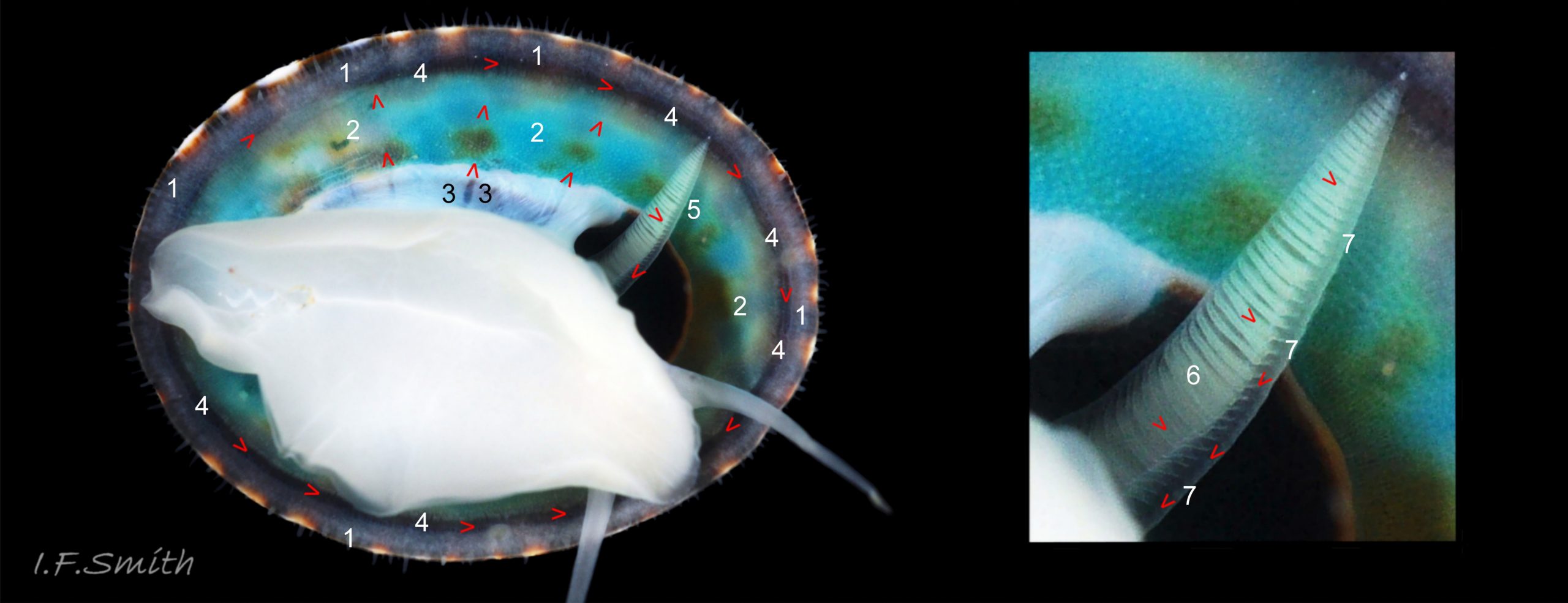Ventral view. Anterior of animal at right of image. Right of animal at top of image.
The mantle cavity consists of a nuchal cavity over the head, and a wide pallial groove around the entire periphery of the foot-head. Unlike patellid limpets, it has no pallial gills in the pallial groove, but does have a large, extendible ctenidium.
The whitish, translucent, peripheral border of the mantle skirt (1) is darkened by the dark shell backing it. It is fringed with translucent, white pallial tentacles
The rest of the translucent mantle skirt (2) shows the green colour of its dorsal surface which is backed by the white of the shell.
Small vessels carry oxygen-depleted, colourless blood from the visceral mass through gaps between the muscle bundles of the pedal retractor muscle (3) and through the green mantle skirt to the efferent pallial vessel.
The large, peripheral, efferent pallial vessel (4) carries oxygen-depleted, blood round the entire animal between zones 1 & 2 of the mantle skirt.
Blood in the efferent pallial vessel travels forwards on both sides, that on the right passes round in front of the head to the left where two vessels carry the blood into the nuchal cavity where it passes through the ctenidium (5) to be oxygenated and then recirculated to the body.
The ctenidium is attached within the left of the nuchal cavity. When the limpet is in motion, the ctenidium protrudes from the right of the cavity and may extend beyond the rim of the shell. At rest, it often contracts 50% and is concealed within the cavity. It consists of a substantial axis with many lamellae resembling the teeth of a comb attached to each side; bipectinate arrangement. The lamellae on the right of the axis are large (6), but those on the left are small, restricted to the distal part of the axis, and often hidden from view so the ctenidium may appear monopectinate, as in this image.
The inhalant current of oxygen-bearing seawater enters the nuchal cavity from the left and passes between the lamellae which absorb the oxygen for blood flowing through them. The oxygenated blood flows into the large branchial efferent vessel (7) in the axis and thence to the heart near the base of the ctenidium to be recirculated through the body.
See also images 22 Testudinalia testudinalis. Littoral. Moray Coast, Banffshire, Scotland. May 2017. Leg. S. Taylor. & 25 Testudinalia testudinalis. Shell length 13.9mm. Littoral. Moray Coast, Banffshire, Scotland. May 2017. Leg. S. Taylor.
APPENDIX re range advance/retreat: flic.kr/p/2jW74ig

